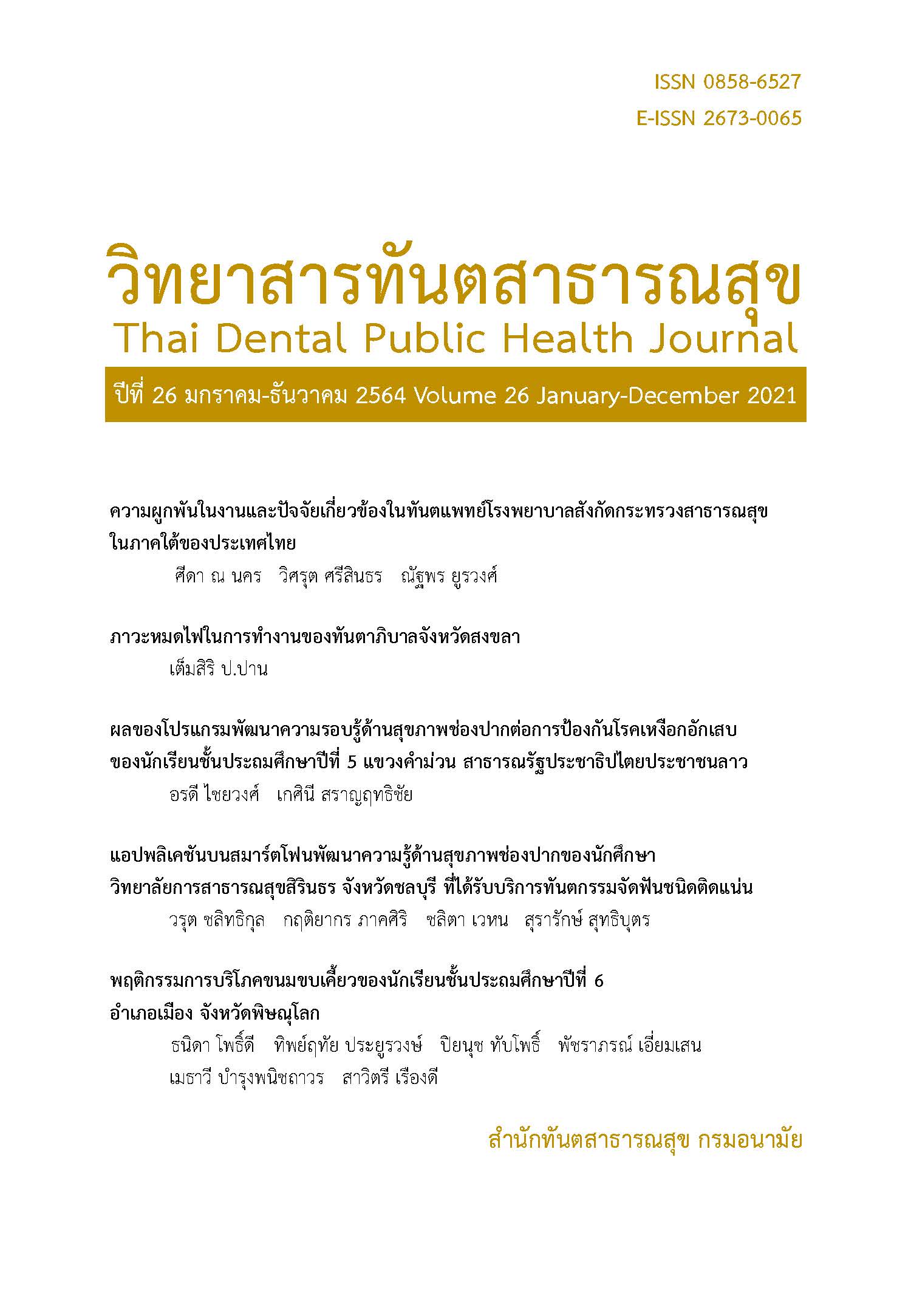Ready-to-eat savouries consumption behavior of sixth grade students in Muang district, Phitsanulok province
Main Article Content
Abstract
The objectives of this descriptive study were to investigate ready-to-eat savouries consumption behaviour and to identify the consumed ready-to-eat savouries based on Thai recommended daily intakes of public sixth-grade students in Muang district, Phitsanulok province. The 321 students of 14 schools from the population of 1,550 students in 51 schools were asked to complete the structured questionnaire from November 2019 to January 2020. The data were analyzed by descriptive statistics and chi-square test.
The mean age of participants was 12.2 years (SD=0.50). They consumed ready-to-eat savouries at least 3 days per week (65.1% of them), an average of 1–2 packs per day, mean expenditure was 26.5 baht per day (SD=18.25) and bought them from stores in or near the schools only 26.9%. The most frequently consumed savouries were potato chips (85.7%) and fried crackers (4.1%) which the main purchase factor was its taste. According to the Guideline Daily Amount (GDA), most of them were classified as the red group having low quality; less nutrition; and high energy, sugars, fats, and salt. Most students consumed the savouries during the meal (81.2%) and before bedtime (17.2%). The study found preliminary relationships between daily pocket money and purchasing behaviour, price, and colour-group identified nutrient content of the savouries (p=0.000, 0.000, 0.000, respectively). Furthermore, store location related to price, group, and color-group (p=0.000, 0.034, 0.000, respectively). According to daily pocket money related to the consumption, mostly were low-quality savouries; therefore, the skill improvement of choosing the savouries properly and using the money for other benefits besides the savoury consumption should be performed.
Downloads
Article Details
References
2. Bureau of Dental Health, Department of Health. The 8th national oral health survey report, 2017. Bangkok: Samcharoen Panich (Bangkok) Co., Ltd. 2018: 86.
3. Marketeer. The market share of snack. 2019. [cited 2020 Aug 20]; Available from: URL: https://marketeeronline.co/archives/125874 (in Thai)
4. Bureau of Nutrition, Department of Health. The standard nutritional guideline for snack, milk, and drink categories in school. in Food, snack, milk, and drink categories for 3-15 year’s child. guideline. (revised version). Bangkok: WVO Officer of Printing Mill, War Veterans Organization of Thailand. 2017. (in Thai)
5. Food division, Food and Drug Administration. 17 food categories guideline. 2018. Available from: URL: https://www.fda.moph.go.th/sites/food/Permission/2.6-17type.pdf (in Thai)
6. Lusas EW. Chapter 1: Overview. In Lusas EW and Rooney LW, (eds). Snack Foods Processing. Snack food processing. Lancaster: Technomic Publishing Company, Inc; 2001. p. 3-28.
7. Jitsuntornchaikul M. Consumer behavior analysis. in Consumer behavior with retailing business. Bangkok: SE-EDUCATION Public Company Limited. 2018: 69-98. (in Thai)
8. Thai Health Promotion Foundation. Snack; the cause of child’s obesity. (no date). Available from: URL: file:///C:/Users/admin/Downloads/%E0%B8%82%E0%B8%99%E0%B8%A1%E0%B8%82%E0%B8%9A%E0%B9%80%E0%B8%84%E0%B8%B5%E0%B9%89%E0%B8%A2%E0%B8%A7%E0%B8%95%E0%B9%89%E0%B8%99%E0%B9%80%E0%B8%AB%E0%B8%95%E0%B8%B8%E0%B9%80%E0%B8%94%E0%B9%87%E0%B8%81%E0%B8%AD%E0%B9%89%E0%B8%A7%E0%B8%99%20(1).pdf (in Thai)
9. Waiudomwut,S. “Snack” cause of Thai child obesity. Fact sheet food 2006; 1:1-2. (in Thai)
10. Sroda R. and Reinhard T. Diet and Dental caries. in Nutrition for Dental Health. Third edition. Chaina: Wolters Kluwer; 2018. p. 203-243.
11. Jaichuen N, Phulkerd S, Chaiyasong S, and Thamarangsi T. Purchasing and Eating of Food and Beverages in Primary 6 Students. Journal of Health Systems research 2013; 7(1): 137-150. (in Thai)
12. Buasri S, Thipsungwan K, and Suntranon A. Food Consumption Behaviors, Fruits and Vegetables Among School-aged Children in Chiang Rai Province. Nursing Journal 2020; 47(2): 24-36. (in Thai)
13. Marketeer. Snack’s market. 2019. Available from: URL: https://marketeeronline.co/archives/125846 (in Thai)
14. Iftikhar A, Zafar M, and Kalar MU. The relationship between snacking habits and dental caries in school children. International Journal of Collaborative Research on Internal Medicine & Public Health 2012; 4(12): 1943-51.
15. Stegeman CA and Davis JR.Nutritional aspects of dental caries: causes, prevention, and treatment. in The dental hygienist’s guide to nutritional care. 4th edition. Chaina: ELSEVIER; 2015. p. 364-380.
16. Bureau of Nutrition, Department of Health. Snack consumption in Thai child. Available from: URL: https://nutrition.anamai.moph.go.th/images/files/%E0%B8%A7%E0%B8%A3%E0%B8%A3%E0%B8%93%E0%B8%8A%E0%B8%99%E0%B8%81-4.%20%E0%B8%A1%E0%B8%B2%E0%B8%95%E0%B8%A3%E0%B8%81%E0%B8%B2%E0%B8%A3%E0%B9%80%E0%B8%94%E0%B9%87%E0%B8%81%E0%B8%AD%E0%B9%89%E0%B8%A7%E0%B8%99.pdf (in Thai)
17. Sawatdee S. Snack consumption behavior of students at high schools in Wattana districs, Bangkok. Thesis. Srinakarinwirot University, Bangkok; 2006. (in Thai)
18. Wangnun N, Piaseu N, and Maruo SJ. Factors Related to Preschoolers’ Snack Consumption Behaviour. Thai Journal of Nursing Council 2017; 32(4): 55-66. (in Thai)
19. Phitsanulok Primary Educational Service Area Office 1. Student informations 10 June 2019. [cited 2019 Jul 20]; Available from: URL: https://www.phitsanulok1.go.th/index.php?data_right_id=142&data_right_read_id=562 (in Thai)
20. Krejcie, RV and Morgan DW. Determining sample size for research activities. Educational and Psychological Measurement 1970; 30(3): 607-610.
21. Ongiem A and Vichitvejpaisal P. Validation of the Tests. Thai J Anesthesiol 2018; 44(1): 36-42. (in Thai)
22. Onyiriuka AN, Egbagbe EE, and Onyiriuka EPA. Snack consumption pattern among adolescent Nigerian urban secondary school girls. Int J Child Adolesc Health 2013; 6(3): 311-317.
23. Marketeer. Decrease in snack consumption during Covid-19. 2021. Available from: URL: https://marketeeronline.co/archives/213782 (in Thai)
24. Rodamphan P. Behavior of teenagers in Mueang Chiang Mai districs towards buying snacks. Independent study. Chiang Mai University, Chiang Mai; 2012.
25. Bardow A and Vissink A. Saliva and caries development. In Fejerskov O, nyvad B, and Kidd E, (eds). Dental caries: the disease and its clinical management. Third edition. Oxford: Wiley Blackwell; 2015. P. 83-106.
26. Miller LMS and Cassady DL. The effects of nutrition knowledge on food label use. A review of the literature. Appetite 2015: 92. 207–216. Available from: URL: file:///C:/Users/admin/Downloads/The_Effects_of_Nutrition_Knowledge_on_Food_Label_U.pdf
27. Yothaphan, T. Application “Food Choice” checking nutritional information before buy. Available from: URL: https://www.thaihealth.or.th/Content/53191-%E0%B8%9C%E0%B8%B8%E0%B8%94%E0%B9%81%E0%B8%AD%E0%B8%9B%E0%B8%AF%20Food%20Choice%20%E0%B9%80%E0%B8%8A%E0%B9%87%E0%B8%81%E0%B8%82%E0%B9%89%E0%B8%AD%E0%B8%A1%E0%B8%B9%E0%B8%A5%E0%B9%82%E0%B8%A0%E0%B8%8A%E0%B8%99%E0%B8%B2%E0%B8%81%E0%B8%B2%E0%B8%A3%E0%B8%81%E0%B9%88%E0%B8%AD%E0%B8%99%E0%B8%8B%E0%B8%B7%E0%B9%89%E0%B8%AD.html
28. Hfocus team. Application FoodChoice: the tool use for scaning nutritional facts and helping the child distance from short and obesity. Available from: URL: https://www.hfocus.org/content/2020/10/20277

